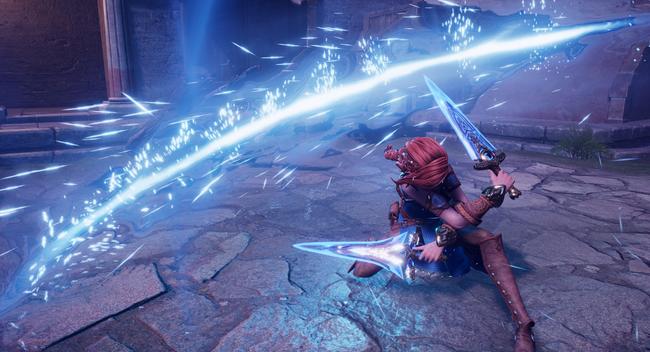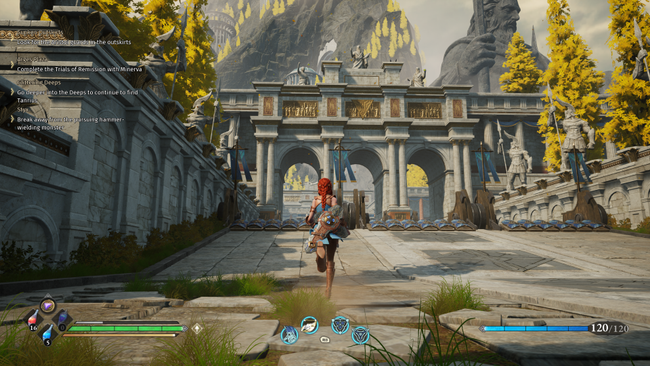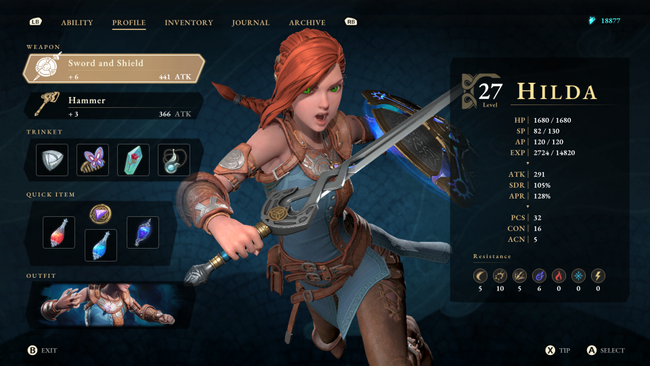Asterigos: Curse of the Stars Review
I wasn't quite sure what to expect, going into Asterigos: Curse of the Stars. It is, after all, the debut title from Taiwanese developer Acme Gamestudio, so there's practically no pedigree to speak of.
However, even with all the other big RPGs from big brands releasing around the clock, sometimes it's nice to experience something new & unknown, something a bit more focused and smaller-scope, and something not tied to any existing brand or property.
And honestly, I enjoyed Asterigos much more than I expected to.

The playable character of Asterigos (that's pronounced AST-terr-reh-gohs) is a young woman named Hilda, a warrior of the Northwind Legion who travels to the cursed city of Aphes to find her missing father & tribemates. Aphes has been stuck in time for centuries, due to the titular Curse of the Stars. As Hilda seeks out her brethren, the history of Aphes & its curse slowly comes to the forefront, and Hilda's actions will unavoidably shape its fate.
Asterigos is an action RPG, where Hilda can simultaneously wield two different weapons from a total of six different types. The combat systems at play actually remind me of Kingdoms of Amalur: Reckoning more than anything else - a game that also placed heavy emphasis on creating attack combos from a weapon pair. As it turns out, there is actually a fair bit of variety that comes from changing up which weapons you decide to wield, as each plays a bit differently.
As you progress through the game, you'll be able to unlock more skills for your desired weapon type, as well as upgrades to passive components such as charge time, shield effectiveness, and similar. All in all, it's not a very ornate or novel combat system, but it's competent and surprisingly versatile.
There are also some hints of inspiration from Souls-like games in Asterigos, but only in a more limited manner. There are conduits scattered around the game world, acting as your places of healing, as well as eventual warp and storage points. By resting at conduits, all nearby enemies will respawn. World navigation also places heavy emphasis on finding your way around to shortcuts - such as dropping down ladders or opening doors from the other unlocked side. There is also no in-game map, so you are coerced to navigate around the world using landmarks and the environment itself.

I think calling Asterigos a Souls-lite is fair, if you must label it. If you tend to shy away from anything Souls-inspired, though, don't fret too much. Asterigos is much more forgiving than most similarly-inspired games. For one, there is a Story difficulty which greatly eases up on any present challenge, for those wanting to leisurely experience Hilda's adventure. But even in its standard mode, the game is more than manageable, as checkpoints and health potions are plenty. It's also worth noting that Asterigos has a fairly standard EXP and leveling system. In some ways, Asterigos feels like an adventure RPG from years past.
Asterigos' narrative is actually, on paper, surprisingly interesting. Soon after Hilda arrives in Aphes, she meets an aristocratic resident named Minerva, who could be argued is - in actuality - the main character of Asterigos' storyline. She's not necessarily a likable person, or the most sympathetic character, but the narrative course runs through Minerva and her actions. She's often at odds with Hilda, especially during the start of the game.
But as you progress through the game, you'll learn how Minerva is tied to the titular Asterigos curse, along with several other characters crucial to the cursed city's history. Perhaps also inspired by the budding Souls-like genre, much of Asterigos' storyline is delivered through in-game diary entries and notes (probably too many notes, to be honest), though standard dialogue sequences are also commonplace. It admittedly took a while to grow on me, but piecing together the mystery surrounding Aphes, experiencing opposing perspectives and clashing factions, the story actually managed to invest my attention. Sort of.
Despite the interesting conceptual premise, however, Asterigos' execution of its narrative is somewhat rough. The script itself is often held back by some awkwardly translated text, and dialogue exchanges also always seem to go about three sentences too long. The game's modest budget does no favors here either, as only the most important lines will be voiced, which sometimes causes conversations between characters to awkwardly toggle between voiced and unvoiced lines, though that's more of a distraction than anything else. Overall, the narrative that surrounds Asterigos is one of those things that I find a conceptually interesting premise, but flawed execution throughout dilutes its effectiveness on the whole.

Asterigos has a respectable presentation overall, from serviceable voice acting, a charming artstyle, good environment aesthetics, and a legible user interface. Asterigos' simple art aesthetic is not only charming, but it's actually something I functionally appreciated, as far as traversing environments go. When I played the souls-like RPG Steelrising last month, the sheer density of visual clutter in the environment design legitimately made it more difficult to determine where I could go & which paths were actually traversable. Sure, it looked nice if you are purely talking about visual fidelity, but it didn't actually do the game any real favors when you actually had to control a character within that game space. I think Asterigos's more stylized art style is not only appealing enough on its own, it is much more conducive to legible environments and being able to navigate them.
That's not to say Asterigos' level design is stellar, though, because there are actually several places that were genuinely frustrating to navigate. Perhaps due to budget constraints, various interior hallways or cave interiors have a tendency to look overly similar to each other, so it's reasonably easy to get confused about where you actually are at times. I've experienced worse on this front, for sure, but still, you should probably expect to get at least a little bit lost at some point.
One of the more bothersome elements of Asterigos is how it handles its quest design. There are numerous sidequests throughout Hilda's adventure involving other residents of the cursed city, and these quests are of varying styles and quality. Hilda even has her own journal that takes note of these sidequests, of which I'm of two minds. Her journal is much more realistic & diegetic compared to most RPGs, with Hilda's notes written in first-person with her own thoughts (and drawings) on the events that transpire. This is actually really nice to see, and I much prefer it over the commonly seen gamey checklist-like quest logs that are often otherwise found in the genre.
However, as a journal, Hilda's notes are often actually useless. She'll include some comments about her opinions on the quest, but little information about what she thinks she may need to do. And oftentimes, the way to actually progress a quest is somewhat opaque. Sometimes you have to speak with a particular NPC at a particular place, selecting a particular dialogue option in order to progress a sidequest. Good luck figuring out where you stand at your sidequest progress if you are coming back to the game from an extended absence, because the journal - despite being a fun look at Hilda's inner monologue - will not be a good resource for actually reminding you what the quest was even about.
Even still, I much prefer this style of quest design more than fetch quests or errands often seen in RPGs. In fact, I had a bit of fun collaborating with other players as the game launched, collectively trying to figure out how a sidequest progresses and what needs to be done. I still think Hilda should take better notes, though.

Asterigos: Curse of the Stars is a better experience than I expected it to be. Despite its shortcomings, such as excessive dialogue, translation oddities, quest issues, and some awkward area design, for those looking for a comfortable action RPG with a satisfying story & competent combat, Asterigos deserves a chance.